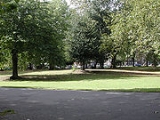
Kennington Park
Encyclopedia
Kennington Park is in Kennington
in London
, England, and lies between Kennington Park Road
and St Agnes Place
. It was opened in 1854. Previously the site had been Kennington Common. This is where the Chartists
gathered for their biggest 'monster rally' on 10 April 1848. Soon after this demonstration the common was enclosed and, sponsored by the royals, made into a public park.
Kennington Common was a site of public executions until 1800 as well as being an area for public speaking
. Some of the most illustrious orators to speak here were Methodist founders George Whitefield
and John Wesley
who is reputed to have attracted a crowd of 30,000.
The common was one of the earliest London cricket
venues and is known to have been used for major cricket matches in 1724. Kennington Park hosts the first inner London community cricket ground, sponsored by Surrey County Cricket Club
whose home, The Oval
, is close to the park.
In the 1970s, the old tradition of mass gatherings returned to the park which was host to the start of many significant marches to Parliament
. Today, this tendency is opposed by a few locals who prefer the model of the Victorian Park. The Friends of Kennington Park, FoKP, provides a local forum for this struggle.
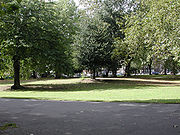
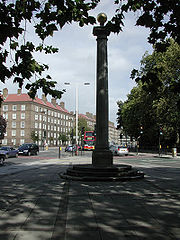 "During the holiday season, Kennington Common in the last (18th) century was an epitome of "Bartlemy Fair," with booths, tents, caravans, and scaffolds, surmounted by flags. It also had one peculiarity, for, as we learn from "Merrie England in the Olden Time," it was a favourite spot for merryandrews, and other buffooneries in open rivalry, and competition with field-preachers and ranters. It was here that Mr. Maw-worm encountered the brickbats of his congregation, and had his "pious tail" illuminated with the squibs and crackers of the unregenerate." (Old and New London: Vol 6 1878 http://www.british-history.ac.uk/report.asp?compid=45285)
"During the holiday season, Kennington Common in the last (18th) century was an epitome of "Bartlemy Fair," with booths, tents, caravans, and scaffolds, surmounted by flags. It also had one peculiarity, for, as we learn from "Merrie England in the Olden Time," it was a favourite spot for merryandrews, and other buffooneries in open rivalry, and competition with field-preachers and ranters. It was here that Mr. Maw-worm encountered the brickbats of his congregation, and had his "pious tail" illuminated with the squibs and crackers of the unregenerate." (Old and New London: Vol 6 1878 http://www.british-history.ac.uk/report.asp?compid=45285)
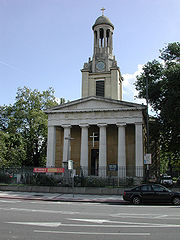
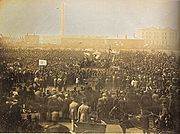
"Inclosure, thou'rt a curse upon the land, And tasteless was the wretch who thy existence plann'd" John Clare
the peasant poet from Peterborough (1793–1864)
By now there were more people in cities than country. London's population had reached 2.5 million.
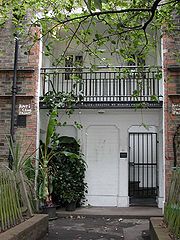
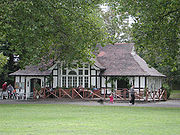

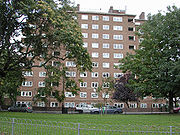
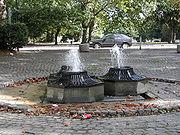
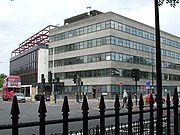
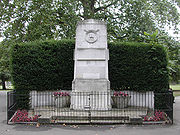
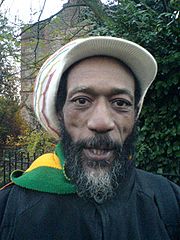
Congratulations to Jonathan Meares the Lambeth parks officer and his team http://www.flickr.com/photos/stefan-szczelkun/180591515/.
Kennington
Kennington is a district of South London, England, mainly within the London Borough of Lambeth, although part of the area is within the London Borough of Southwark....
in London
London
London is the capital city of :England and the :United Kingdom, the largest metropolitan area in the United Kingdom, and the largest urban zone in the European Union by most measures. Located on the River Thames, London has been a major settlement for two millennia, its history going back to its...
, England, and lies between Kennington Park Road
Kennington Park Road
Kennington Park Road is a main road in south-east London, England, and is part of the A3 trunk road. It runs from Newington Butts at its Y-junction with Kennington Lane, south-west to the Oval, where the A3 continues as Clapham Road, towards Stockwell...
and St Agnes Place
St Agnes Place
St Agnes Place was a squatted street in Kennington, South London, which resisted eviction orders for more than 30 years.- History :On 1 June 1969 house number 54 was the first to be squatted. The council had acquired the unit and planned to demolish it for the extension to Kennington Park. The...
. It was opened in 1854. Previously the site had been Kennington Common. This is where the Chartists
Chartism
Chartism was a movement for political and social reform in the United Kingdom during the mid-19th century, between 1838 and 1859. It takes its name from the People's Charter of 1838. Chartism was possibly the first mass working class labour movement in the world...
gathered for their biggest 'monster rally' on 10 April 1848. Soon after this demonstration the common was enclosed and, sponsored by the royals, made into a public park.
Kennington Common was a site of public executions until 1800 as well as being an area for public speaking
Public speaking
Public speaking is the process of speaking to a group of people in a structured, deliberate manner intended to inform, influence, or entertain the listeners...
. Some of the most illustrious orators to speak here were Methodist founders George Whitefield
George Whitefield
George Whitefield , also known as George Whitfield, was an English Anglican priest who helped spread the Great Awakening in Britain, and especially in the British North American colonies. He was one of the founders of Methodism and of the evangelical movement generally...
and John Wesley
John Wesley
John Wesley was a Church of England cleric and Christian theologian. Wesley is largely credited, along with his brother Charles Wesley, as founding the Methodist movement which began when he took to open-air preaching in a similar manner to George Whitefield...
who is reputed to have attracted a crowd of 30,000.
The common was one of the earliest London cricket
Cricket
Cricket is a bat-and-ball game played between two teams of 11 players on an oval-shaped field, at the centre of which is a rectangular 22-yard long pitch. One team bats, trying to score as many runs as possible while the other team bowls and fields, trying to dismiss the batsmen and thus limit the...
venues and is known to have been used for major cricket matches in 1724. Kennington Park hosts the first inner London community cricket ground, sponsored by Surrey County Cricket Club
Surrey County Cricket Club
Surrey County Cricket Club is one of the 18 professional county clubs which make up the English and Welsh domestic cricket structure, representing the historic county of Surrey. Its limited overs team is called the Surrey Lions...
whose home, The Oval
The Oval
The Kia Oval, still commonly referred to by its original name of The Oval, is an international cricket ground in Kennington, in the London Borough of Lambeth. In the past it was also sometimes called the Kennington Oval...
, is close to the park.
In the 1970s, the old tradition of mass gatherings returned to the park which was host to the start of many significant marches to Parliament
Parliament
A parliament is a legislature, especially in those countries whose system of government is based on the Westminster system modeled after that of the United Kingdom. The name is derived from the French , the action of parler : a parlement is a discussion. The term came to mean a meeting at which...
. Today, this tendency is opposed by a few locals who prefer the model of the Victorian Park. The Friends of Kennington Park, FoKP, provides a local forum for this struggle.
Pre 1600

- c1500 BC Recently discovered post stumps in the south ThamesRiver ThamesThe River Thames flows through southern England. It is the longest river entirely in England and the second longest in the United Kingdom. While it is best known because its lower reaches flow through central London, the river flows alongside several other towns and cities, including Oxford,...
foreshore near Vauxhall BridgeVauxhall BridgeVauxhall Bridge is a Grade II* listed steel and granite deck arch bridge in central London. It crosses the River Thames in a south–east north–west direction between Vauxhall on the south bank and Pimlico on the north bank...
point to a ritual jetty or possibly the first London bridge, by the outlet of the River EffraRiver EffraThe River Effra is a river in south London, England. It is now mainly underground. The name cannot be traced back much earlier than 1840 , so speculation that it came from a Celtic word for torrent is unwarranted...
. The Effra formed the southerly boundary to the common. Three closely related geographic features defined the area of Kennington Common as sacred in ancient times. The sharp bend in the river Effra before it flowed into the Thames, a strategic mound or tumulusTumulusA tumulus is a mound of earth and stones raised over a grave or graves. Tumuli are also known as barrows, burial mounds, Hügelgrab or kurgans, and can be found throughout much of the world. A tumulus composed largely or entirely of stones is usually referred to as a cairn...
, and an important fork in the main road from the river crossing which is now known as London BridgeLondon BridgeLondon Bridge is a bridge over the River Thames, connecting the City of London and Southwark, in central London. Situated between Cannon Street Railway Bridge and Tower Bridge, it forms the western end of the Pool of London...
. This made it a sacred place of 'national' assembly which may have related to the jetty or bridge. - The mound may have also been used by the locals of the South London marsh community as a refuge from tidal flash floods. As the flood water receded, the river silt left a level playing field - ideal for grazing animals or, playing team ball games.
- It should be noted that this ancient history of the park has to be inferred from analysis of its archeology and landscape, since written records of the area are only available for the past 400 years or so.
17th century
- 1600 gives the first record of the common. "The common was bounded on the South West by Vauxhall Creek" It seems that the common extended over marshy land to the South West of the Roman Road Stane Street, now Kennington Park Road. When the common became bounded by the Kennington Park Road is not known. There is a 1660 record of a common keeper being paid for grazing. See commonerCommonerIn British law, a commoner is someone who is neither the Sovereign nor a peer. Therefore, any member of the Royal Family who is not a peer, such as Prince Harry of Wales or Anne, Princess Royal, is a commoner, as is any member of a peer's family, including someone who holds only a courtesy title,...
- 1661 The infamous Vauxhall Pleasure Gardens are laid out nearby.
- 1678 First recorded execution at Kennington Common was that of Sarah Elston who was burnt for murdering her husband. Kennington Common was the South London equivalent of TyburnTyburn, LondonTyburn was a village in the county of Middlesex close to the current location of Marble Arch in present-day London. It took its name from the Tyburn or Teo Bourne 'boundary stream', a tributary of the River Thames which is now completely covered over between its source and its outfall into the...
(now Marble ArchMarble ArchMarble Arch is a white Carrara marble monument that now stands on a large traffic island at the junction of Oxford Street, Park Lane, and Edgware Road, almost directly opposite Speakers' Corner in Hyde Park in London, England...
). - 1678 24 April John Masters and Gabriel Dean, highwaymen, executed.
- 1679 7 Dorothy Lillingstone was executed for murder.
- 1685 29 June, William Disney was executed for High Treason. http://web.ukonline.co.uk/localonline/d/0023kpex.htm
18th century

- 1724 18: LondonLondon Cricket ClubThe original London Cricket Club was formed by 1722 and was one of the foremost clubs in English cricket over the next four decades. It is closely associated with the Artillery Ground, where it played most of its home matches.-Early history of London cricket:...
v DartfordDartford Cricket ClubDartford Cricket Club is one of the oldest in England and its origins go back to the early 18th century, perhaps earlier.See also: Dartford Brent...
is the earliest known major cricket match on Kennington Common (St James Evening Post, 16 June) http://www.pcboard.com.pk/Archive/Grounds/11/2794_misc.html - 1725 First record of the Green Man and Horns tavern near Kennington Common. The cricket played on the common used the Horns as a base. Also other sports including quoits and bowling were played.
- 1739 Methodists John Wesley and George WhitefieldGeorge WhitefieldGeorge Whitefield , also known as George Whitfield, was an English Anglican priest who helped spread the Great Awakening in Britain, and especially in the British North American colonies. He was one of the founders of Methodism and of the evangelical movement generally...
preach to 30,000. Whitefield is remembered in the nearby 'Whitefield House' home of the Evangelical AllianceEvangelical AllianceThe Evangelical Alliance is a London-based charitable organization founded in 1846. It has a claimed representation of over 1,000,000 evangelical Christians in the United Kingdom and is the oldest alliance of evangelical Christians in the world....
. Dissenting Methodists, such as the son of a slave Robert Wedderburn, spoke in a more radical voice on Kennington Common speaking out against the enclosures and slaverySlaverySlavery is a system under which people are treated as property to be bought and sold, and are forced to work. Slaves can be held against their will from the time of their capture, purchase or birth, and deprived of the right to leave, to refuse to work, or to demand compensation...
(active from 1786 through 1813). Kennington Common was a key South London place for public speakingPublic speakingPublic speaking is the process of speaking to a group of people in a structured, deliberate manner intended to inform, influence, or entertain the listeners...
, acting as a kind of open air free university of the day. - 1739 14 John Hannah executed for robbery and perjury. See an image of him here http://web.ukonline.co.uk/localonline/d/0026jhan.htm
- 1743 24 James Hunt and Thomas Collins hanged for sodomySodomySodomy is an anal or other copulation-like act, especially between male persons or between a man and animal, and one who practices sodomy is a "sodomite"...
at Kennington Common gallows - 1746 July 30 Col. Francis TowneleyFrancis TowneleyFrancis Towneley , was an English Jacobite who was executed for his role in the rebellion of 1745.-Early life:He was the fifth son of Charles Towneley of Towneley Hall, Lancashire, by his wife Ursula, daughter of Richard Fermor of Tusmore, Oxfordshire.His family were Roman catholics and Jacobite...
and eight men of the Manchester Regiment who had taken part in the Jacobite RisingJacobite risingThe Jacobite Risings were a series of uprisings, rebellions, and wars in Great Britain and Ireland occurring between 1688 and 1746. The uprisings were aimed at returning James VII of Scotland and II of England, and later his descendants of the House of Stuart, to the throne after he was deposed by...
were hanged, drawn and quartered. - 1749 12 April Richard Coleman executed "for a murder he did not committ" Source: The Complete Newgate Calendar Vol 3 http://tarlton.law.utexas.edu/lpop/etext/newgate3/coleman.htm
- 1751 A road was "cut through gardens 80 foot wide" from Kennington Common to Westminster Bridge. (Gentleman's Magazine Monday 16 December 1751). The road is Kennington RoadKennington RoadKennington Road is a long straight road, approximately a mile in length, in the London Borough of Lambeth in London, England, running south from Westminster Bridge Road to Kennington Park Road....
and comes up to the common next to the Horns tavern. - 1767 The common was flooded by a high tide coming up Vauxhall Creek.
- 1785 Last known use of the Common as a venue for major cricket.
- 1790 William BlakeWilliam BlakeWilliam Blake was an English poet, painter, and printmaker. Largely unrecognised during his lifetime, Blake is now considered a seminal figure in the history of both the poetry and visual arts of the Romantic Age...
moved to North Lambeth and may have attended commons meetings in the 1790s, in all likelihood with Thomas PaineThomas PaineThomas "Tom" Paine was an English author, pamphleteer, radical, inventor, intellectual, revolutionary, and one of the Founding Fathers of the United States... - 1792 Mungo, a black prize fighter breaks the jaw of his opponent, a carpenter, in a boxingBoxingBoxing, also called pugilism, is a combat sport in which two people fight each other using their fists. Boxing is supervised by a referee over a series of between one to three minute intervals called rounds...
match on the common. (Peter Linebaugh The London Hanged Verso 2003 p. 414) - 1795 3 August Lewis Jeremiah Avershaw an infamous highwayman, was executed for shooting a Peace Officer http://exclassics.com/newgate/ng387.htm
- 1799 The last person to be hanged at the common (six years after public execution was ended at Tyburn) was a fraudster from nearby CamberwellCamberwellCamberwell is a district of south London, England, and forms part of the London Borough of Southwark. It is a built-up inner city district located southeast of Charing Cross. To the west it has a boundary with the London Borough of Lambeth.-Toponymy:...
by the name Badger - "The Gymnastic SocietyThe Gymnastic SocietyThe Gymnastic Society was an eighteenth-century London sports club for the pursuit of football and wrestling. It is arguably the first football club.-Background:...
" met regularly at Kennington Common during the second half of the eighteenth century to play footballFootballFootball may refer to one of a number of team sports which all involve, to varying degrees, kicking a ball with the foot to score a goal. The most popular of these sports worldwide is association football, more commonly known as just "football" or "soccer"...
The Society - arguably the world's first football club - consisted of London-based natives of CumberlandCumberlandCumberland is a historic county of North West England, on the border with Scotland, from the 12th century until 1974. It formed an administrative county from 1889 to 1974 and now forms part of Cumbria....
and WestmorelandWestmorelandWestmoreland is a historic county in England. It may also refer to:-Places:Australia*Westmoreland County, New South WalesCanada*Westmorland County, New BrunswickJamaica*Westmoreland, Jamaica, a parishNew Zealand...
.
19th century

- 1800 The much-respected Mr Briant becomes landlord of the Horns runs a famous Glee ClubGlee clubA glee club is a musical group or choir group, historically of male voices but also of female or mixed voices, which traditionally specializes in the singing of short songs—glees—by trios or quartets. In the late 19th Century it was very popular in most schools and was made a tradition...
. Briant died 1852 but his relatives still live in Kennington, one of whom chaired the Parks Management Advisory Committee in 1996.
- 1815 February A mob breaks windows 'round the Horns'. LifeGuards called out to quell the mob. The Riot Act was read. In 1819 The Peterloo Massacre signaled an end to repression by violence.
- 1818 Camberwell New Road built east/west cutting the southern corner of the common off from the rest of it.
- 1824 St Marks Church by D.R.Roper, built on an enclosed corner of the common, over the river Effra. Promoted by The Church of EnglandChurch of EnglandThe Church of England is the officially established Christian church in England and the Mother Church of the worldwide Anglican Communion. The church considers itself within the tradition of Western Christianity and dates its formal establishment principally to the mission to England by St...
as the 'salvation of the common', twenty four years later it was the vicar of this church who led the move to enclose the whole common. - 1832 First Reform Act, after which hustings were set up on Kennington Common (outside The Horns)
- 1845 Surrey County Cricket ClubSurrey County Cricket ClubSurrey County Cricket Club is one of the 18 professional county clubs which make up the English and Welsh domestic cricket structure, representing the historic county of Surrey. Its limited overs team is called the Surrey Lions...
formed (22 August formally constituted on 18 October) at the Horns

- 1848 10 April ChartistChartismChartism was a movement for political and social reform in the United Kingdom during the mid-19th century, between 1838 and 1859. It takes its name from the People's Charter of 1838. Chartism was possibly the first mass working class labour movement in the world...
mass meeting organised by Black Briton and leader of London Chartists William CuffayWilliam CuffayWilliam Cuffay was a Chartist leader in early Victorian London.- Background :Cuffay was mixed race, the son of a Gillingham, Kent woman and a slave from Saint Kitts, then a British colony. He was born in 1788 in Old Brompton, an area of the Medway Towns that is now in Gillingham...
. Chartism was a federation of different groups who had agreed on a set of political demands for an inclusive people's democracy. Chartism was the first British national working class organisation. This was a year known for its revolutions (see Revolution of 1848). - 1848 10 First photograph of a crowd taken by William Kilburn probably from the Horns. The Daguerrotype negative is now kept by and copyright Queen ElizabethElizabeth II of the United KingdomElizabeth II is the constitutional monarch of 16 sovereign states known as the Commonwealth realms: the United Kingdom, Canada, Australia, New Zealand, Jamaica, Barbados, the Bahamas, Grenada, Papua New Guinea, the Solomon Islands, Tuvalu, Saint Lucia, Saint Vincent and the Grenadines, Belize,...
and is kept in the Royal archives at Windsor CastleWindsor CastleWindsor Castle is a medieval castle and royal residence in Windsor in the English county of Berkshire, notable for its long association with the British royal family and its architecture. The original castle was built after the Norman invasion by William the Conqueror. Since the time of Henry I it...
. - Around 1849 William BoothWilliam BoothWilliam Booth was a British Methodist preacher who founded The Salvation Army and became its first General...
preached here. - 1852 Kennington Common was enclosed. The petition for enclosure was led by the vicar of St Marks, aided by the young Prince of Wales. No more gathering or vulgar recreations were allowed without permission. The sacred mound was levelled, the common fenced and landscaped into an urban park. Planted with mostly sapling London Plane trees (which are still living). North and South game pitches are fenced with iron railings (removed during the Second World War).
"Inclosure, thou'rt a curse upon the land, And tasteless was the wretch who thy existence plann'd" John Clare
John Clare
John Clare was an English poet, born the son of a farm labourer who came to be known for his celebratory representations of the English countryside and his lamentation of its disruption. His poetry underwent a major re-evaluation in the late 20th century and he is often now considered to be among...
the peasant poet from Peterborough (1793–1864)
By now there were more people in cities than country. London's population had reached 2.5 million.

- 1853 Prince Consort Model Lodge (aka 'Prince Albert's Cottages') re-erected from the Great Exhibition (where they were provided by the Society for the Improvement of the Condition of the Labouring Classes) and back porch added. Architect: Herny Roberts.
- 1853 September The new toll house opens at the fork in Kennington Park Road
- 1854 Kennington Park opened and maintained by the Crowns Office of Works
- 1859 Vauxhall Pleasure Gardens opened for the last time on the night of Monday, 25 July 1859.
- 1861 Two panelled gardens laid out by John Gibson on the west side to either side the lodge.
- 1861 A gymnasium erected (which became tennis courts before the children's playground moved there in 2006)
- 1861 Meeting of the Juvenile TemperanceTemperance movementA temperance movement is a social movement urging reduced use of alcoholic beverages. Temperance movements may criticize excessive alcohol use, promote complete abstinence , or pressure the government to enact anti-alcohol legislation or complete prohibition of alcohol.-Temperance movement by...
Society allowed in the summer. (PRO work 1/71) - 1862 Felix SladeFelix SladeFelix Joseph Slade FRA , was an English lawyer and collector of glass, books and engravings.A fellow of the Society of Antiquaries and a philanthropist who endowed three Slade Professorships of Fine Art at Oxford University and Cambridge University, and at University College London, where he also...
drinking water fountain designed by Charles Henry DriverCharles Henry DriverCharles Henry Driver was a significant British architect of the Victorian era, with a reputation for pioneering use of ornamental iron work for which he was seen as a leading authority. He was also an expert in its casting and manufacture. He consulted in this area for Joseph Paxton on The Crystal...
. Slade donated this after feeling sorry for the local children who, after playing in the gymnasium, had been taking their refreshment from the cab horse trough. - 1869 Sir Henry DoultonHenry DoultonSir Henry Doulton was an English businessman, inventor and manufacturer of pottery, instrumental in developing the firm of Royal Doulton....
donates local artist George TinworthGeorge TinworthGeorge Tinworth was an English ceramic artist who worked for the Doulton factory at Lambeth from 1867 until his death.-Life:...
's 'Fountain of Life' - 1867 Second Reform ActReform ActIn the United Kingdom, Reform Act is a generic term used for legislation concerning electoral matters. It is most commonly used for laws passed to enfranchise new groups of voters and to redistribute seats in the British House of Commons...
Lower middle class and artisans get the vote - 1874 Parish of St Agnes, Kennington Park founded.
- 1877 Church of St Agnes, Kennington Park consecrated by the Lord Bishop of London.
- 1884 Third Reform Act All adult men get the vote.
- 1887 Kennington Park maintenance passed over to London's Metropolitan Board of WorksMetropolitan Board of WorksThe Metropolitan Board of Works was the principal instrument of London-wide government from 1855 until the establishment of the London County Council in 1889. Its principal responsibility was to provide infrastructure to cope with London's rapid growth, which it successfully accomplished. The MBW...
- 1889 Kennington Park passed to London County CouncilLondon County CouncilLondon County Council was the principal local government body for the County of London, throughout its 1889–1965 existence, and the first London-wide general municipal authority to be directly elected. It covered the area today known as Inner London and was replaced by the Greater London Council...
that later became the Greater London CouncilGreater London CouncilThe Greater London Council was the top-tier local government administrative body for Greater London from 1965 to 1986. It replaced the earlier London County Council which had covered a much smaller area...
, GLC, in 1965 - 1896 A 7 year old Charlie Chaplin spent a day playing in the park after his mother discharged the family from the Lambeth Workhouse in desperation to see her children. After a day in the park and at a coffee-shop they returned to the workhouse to undergo the shameful admissions process again.
- 1897 An Arts & CraftsArts and Crafts movementArts and Crafts was an international design philosophy that originated in England and flourished between 1860 and 1910 , continuing its influence until the 1930s...
style refreshment house erected which is now a rare survival. - 1898 Princess of Wales Theatre, designed by W. G. R. SpragueW. G. R. SpragueW. G. R. Sprague was a theatre architect in the grand age.Born in Australia, the son of actress Dolores Drummond who returned with acclaim to London in 1874. Sprague was articled to Frank Matcham for four years, then in 1880 to Walter Emden for three years; and then in partnershp with Bertie Crewe...
, opens at the height of the music hall era. (closed c.1934 and site 'Compulsorily Purchased' for flats in 1949) The theatre had one of earliest air conditioningAir conditioningAn air conditioner is a home appliance, system, or mechanism designed to dehumidify and extract heat from an area. The cooling is done using a simple refrigeration cycle...
systems. - 1899 The first all-night illuminated footpath through a public park.
20th century

- 1900 BandstandBandstandA bandstand is a circular or semicircular structure set in a park, garden, pier, or indoor space, designed to accommodate musical bands performing concerts...
completed with seated concerts from military bands playing there until 1950 Sundays, Wednesdays and bank holidays - This was 'Rational Recreation' set against the vulgarity of the surrounding music hall and tavern culture. Charlie ChaplinCharlie ChaplinSir Charles Spencer "Charlie" Chaplin, KBE was an English comic actor, film director and composer best known for his work during the silent film era. He became the most famous film star in the world before the end of World War I...
grew up locally and is said to have met his first girlfriend in the park. His errant father habituated the Horns. - 1914 c "The ancient privileges of the 'ton' are preserved, however, on a triangular piece of ground fenced off for the purpose (the site probably of the mound), where a notice states that here public meetings may be held." 'A tradition may neither be made nor destroyed' Benjamin DisraeliBenjamin Disraeli, 1st Earl of BeaconsfieldBenjamin Disraeli, 1st Earl of Beaconsfield, KG, PC, FRS, was a British Prime Minister, parliamentarian, Conservative statesman and literary figure. Starting from comparatively humble origins, he served in government for three decades, twice as Prime Minister of the United Kingdom...
(from Prehistoric London: its mounds and circles, by E. O. Gordon Covenant Publishing 1914) - 1914 c The railings were removed for war use. The first bomb dropped on London in World War IWorld War IWorld War I , which was predominantly called the World War or the Great War from its occurrence until 1939, and the First World War or World War I thereafter, was a major war centred in Europe that began on 28 July 1914 and lasted until 11 November 1918...
is said to have been dropped from a ZeppelinZeppelinA Zeppelin is a type of rigid airship pioneered by the German Count Ferdinand von Zeppelin in the early 20th century. It was based on designs he had outlined in 1874 and detailed in 1893. His plans were reviewed by committee in 1894 and patented in the United States on 14 March 1899...
on the south field. - 1920 Kennington Park Extension Committee formed who bought land that became the swimming pool, flower garden and children's playground
- 1924 War MemorialWar memorialA war memorial is a building, monument, statue or other edifice to celebrate a war or victory, or to commemorate those who died or were injured in war.-Historic usage:...
designed by Lucas Lancaster and Lodge erected (by public subscription?) - 1926 The park occupied during the General StrikeGeneral strikeA general strike is a strike action by a critical mass of the labour force in a city, region, or country. While a general strike can be for political goals, economic goals, or both, it tends to gain its momentum from the ideological or class sympathies of the participants...
- 1928 Females finally enfranchised

- 1930s Wooden shelter (replaced in the 1950s and repaired at the end of 2006)
- 1931 Old English Garden designed by Col. J. J. Sexby opened
- 1931 The Lido provided by the LCC was opened (It closed at the end of the 1987 season - see external link below)
- 1934 Last license given to Princess of Wales Theatre...
- 1938 Architecturally bland Park Superintendent's house built in north east corner.
- 1940 The local areas of LambethLambethLambeth is a district of south London, England, and part of the London Borough of Lambeth. It is situated southeast of Charing Cross.-Toponymy:...
and SouthwarkSouthwarkSouthwark is a district of south London, England, and the administrative headquarters of the London Borough of Southwark. Situated east of Charing Cross, it forms one of the oldest parts of London and fronts the River Thames to the north...
very heavily bombed in The BlitzThe BlitzThe Blitz was the sustained strategic bombing of Britain by Nazi Germany between 7 September 1940 and 10 May 1941, during the Second World War. The city of London was bombed by the Luftwaffe for 76 consecutive nights and many towns and cities across the country followed...
. - 1940? Horns pub bomb damaged
- 1940 15. A public bomb shelter dug as a grid of trenches in the field, known as the 'south pitch', suffers a direct hit. An estimated 104 people are killed. Only c. 50 bodies could be identified by name. Due to treacherous wet ground conditions, with the shelter walls collapsing on rescuers, the remains of up to another 54 local people were left in the ground, covered in lime, and the trenches were filled in.
- 1940 The Park used for allotments so people can grow their own food. (source: aerial photos taken by the Royal Air Force)
- 1949 A 24 ft high illuminated Christmas tree erected in the park

- 1950s The Horns Tavern was 'one of the most famous landmarks of South London'. It is still remembered as being a centre of Kennington's community spirit in the Fifties.
- 1958 24, St Agnes new parish church, designed by Ralph Covell, (who was the parish organist) is consecrated by the Lord Bishop of Kingston. The old church was demolished in the 1940s following bombing by enemy action. John Betjeman, poet laureate, dedicated his first Collins Guide to the English Parish Church to the memory of St Agnes Kennington Park, describing it as being “…destroyed by the diocese of Southwark after some war damage.”
- 1960s Horns demolished (replaced by Col. Richard Siefert's Department of Social Security - see photo) From a social centre to a centre of social control?
- 196? Land to the east of St Agnes Place is designated public open space that becomes Kennington Park East.
- 1963 Two piece bronze Reclining Figure No 3 by sculptor Henry MooreHenry MooreHenry Spencer Moore OM CH FBA was an English sculptor and artist. He was best known for his semi-abstract monumental bronze sculptures which are located around the world as public works of art....
bought for the new prizewinning Brandon Highrise Estate, Southwark (adjacent to Kennington Park East) - 1971 Control of the park passes to Lambeth Council.
- c1976 Radical religion returns to Kennington Park with the establishment of the RastafarianRastafari movementThe Rastafari movement or Rasta is a new religious movement that arose in the 1930s in Jamaica, which at the time was a country with a predominantly Christian culture where 98% of the people were the black descendants of slaves. Its adherents worship Haile Selassie I, Emperor of Ethiopia , as God...
Temple in St Agnes Place backing onto the park. - 1974 St Agnes Place housing squatted and defended against demolition (1977) with a high court injunction (the first to be obtained by telephone)
- 1977 Bob MarleyBob MarleyRobert Nesta "Bob" Marley, OM was a Jamaican singer-songwriter and musician. He was the rhythm guitarist and lead singer for the ska, rocksteady and reggae band Bob Marley & The Wailers...
visits the Rastafarian Temple frequently whilst recording his record "Exodus" in London. He also enjoyed playing football with friends in the park. - 1978 The Kennington Skateboarding Bowl was erected on the site of derelict netball courts.
- 1978 November Public gatherings return to the park with a municipal firework display and bonfire.
- 1981 Lambeth Fightback Campaign used the park as an assembly point. This was the first recorded use of the park for a political gathering since the enclosure.
- 1984 Oval Fountain designed by landscape architect Georgina Livingston.

- 1986 5 Gay PrideGay prideLGBT pride or gay pride is the concept that lesbian, gay, bisexual, and transgender people should be proud of their sexual orientation and gender identity...
march started in Kennington Park, followed in the next ten years by many political rallies. - 1988 The much loved but neglected swimming pool is closed, filled in and covered with tennis courts.
- 1990 31 A branch of the historic Poll TaxPoll taxA poll tax is a tax of a portioned, fixed amount per individual in accordance with the census . When a corvée is commuted for cash payment, in effect it becomes a poll tax...
march starts in the park. - 1996 KP Management Advisory Committee (the MAC) started by Lambeth Council prepares lottery bid with the architect Carl Callaghan.
- 1997 A 16 page pamphlet on the park's history from a working class viewpoint written and published by Stefan Szczelkun. In the following year it sells over 1,000 copies in local newsagents and bookshops.
- 1998 10 The 150th anniversary of the Chartist rally was commemorated with banners, song and play, by a motley crew of laterday Chartists organised by Marianne and Louisa.
- 1998 12 Reclaim the StreetsReclaim the StreetsReclaim The Streets is a collective with a shared ideal of community ownership of public spaces. Participants characterize the collective as a resistance movement opposed to the dominance of corporate forces in globalization, and to the car as the dominant mode of transport.-Protests:Reclaim The...
and Liverpool Dockers March rally sets off from the park
21st century

- 2001 Last municipal fireworks display.. This was the only park event attended annually by almost everyone locally. (Patrick Keiller's film 'London' (1993) has a long sequence of the bonfire.)
- 2002 July Park Arts event. 12 artists install work in the park for the day.
- 2002 Inaugural meeting of Friends of Kennington Park, FoKP. Their formation is sparked by concern for the current condition and up-keep of the park, which is very poor. The cafe is in disrepair and shut.
- 2002 Organised cricket returns to Kennington Park with Tony Moody's inner-city cricket project. Kennington United CC is financially supported by Surrey CCC, based nearby at The OvalThe OvalThe Kia Oval, still commonly referred to by its original name of The Oval, is an international cricket ground in Kennington, in the London Borough of Lambeth. In the past it was also sometimes called the Kennington Oval...
and receives coaching from professional players. - 2002 The renovated cafe re-opens and becomes a popular haven of relaxation.
- 2003 Trees for London (now called Trees for CitiesTrees for Cities-History:The charity was founded in 1993, initially as Trees for London to "advance the education of the public in the appreciation of trees and their amenity value, and in furtherance of this the planting and protection of trees everywhere, and in particular inner city areas"...
) moves into Prince Consort Lodge and hold a very well attended community tree planting day in the park on 29 March 2003. - 2003 Lambeth council get eviction order against St Agnes Place.
- 2003 12 First memorial service at St Marks for those who died in the park bomb shelter in 1940.
- 2004 5 A march to start the Cannabis Festival in Brockwell Park started from Kennington Park.

- 2004 cJune Lambeth Council posters announce illegality of ad-hoc barbecues in the park.
- 2004 The Public Toilets are finally reopened.
- 2004 July Jumble sale organised by Cathy Preece raises over £700 for park bird boxes made by local community eco group Roots & Shoots http://www.cix.co.uk/~museumgh/rootsandshoots.htm
- 2004 August An EcuadorEcuadorEcuador , officially the Republic of Ecuador is a representative democratic republic in South America, bordered by Colombia on the north, Peru on the east and south, and by the Pacific Ocean to the west. It is one of only two countries in South America, along with Chile, that do not have a border...
ian community group are excluded from using the park for volleyball, after complaints over public health matters are received by the council. - 2004 4: Commemoration of the 150th anniversary of the park with a funday organised by FoKP.
- 2004 October 'SaveKPVolleyball' campaign group sends an open letter to Lambeth Council defending the use of the park for Ecuadorian community volleyball. But volleyball continues to be excluded.
- 2004 November/December Birdboxes are installed by Roots & Shoots, as reported in South London Press Friday, December 3, 2004 Page 7
- 2005 12 Community Planting Day in Kennington Park east, to define the boundary of the new cricket pitch. Young cricketers and other local volunteers do the planting including fifteen Lime trees. Trees for Cities with Friends of KP.
- 2005 29. Riot police evict the squatters in St Agnes PlaceSt Agnes PlaceSt Agnes Place was a squatted street in Kennington, South London, which resisted eviction orders for more than 30 years.- History :On 1 June 1969 house number 54 was the first to be squatted. The council had acquired the unit and planned to demolish it for the extension to Kennington Park. The...
adjoining the park. The Rastafarian Temple is temporarily spared. Demolition of all the houses follows. - 2006 17 Kennington United Cricket Club play their first formal at home game at Kennington Park against Temple Bar. TB batted first, 169 all out. KUCC won 173 - 6

- 2006 14 A memorial is unveiled to victims of Blitz entombed in the park shelter. Designed by sculptor Richard Kindersley, it takes the form of a rough slab of Caithness stone, and bears the dedication: To commemorate the wartime suffering of the people of Kennington and in particular over 50 men, women and children who were killed on 15 October 1940 when a bomb destroyed an air-raid shelter near this spot. Rest in peace. It also bears an inscription from poet Maya AngelouMaya AngelouMaya Angelou is an American author and poet who has been called "America's most visible black female autobiographer" by scholar Joanne M. Braxton. She is best known for her series of six autobiographical volumes, which focus on her childhood and early adult experiences. The first and most highly...
: History despite its wrenching pain cannot be unlived but if faced with courage need not be lived again. - 2006 Has been a good year for the park in terms of material improvements. There has been: a new fitness course; a new playground (with old toilets converted and attached); a five aside /basketball court where the playground used to be; a temporary pavilion for the Cricket club; new tennis court surfaces (and summer tennis school); renewal of the all weather pitch surfaces; the memorial to the civilians who died in the park in WW2; repair and painting of the wooden shelter; the green link between old and east extension completed and opened; many new steel benches provided by the 'Friends of Kennington Park'; draining and reseeding of the football pitch on KP east.
Congratulations to Jonathan Meares the Lambeth parks officer and his team http://www.flickr.com/photos/stefan-szczelkun/180591515/.
- 2007 24 The Archbishop of CanterburyArchbishop of CanterburyThe Archbishop of Canterbury is the senior bishop and principal leader of the Church of England, the symbolic head of the worldwide Anglican Communion, and the diocesan bishop of the Diocese of Canterbury. In his role as head of the Anglican Communion, the archbishop leads the third largest group...
was amongst the speakers at an outdoor service to commemorate the passing of the Slave Trade Act 1807. - 2007 12 The Rastafarian Temple on St Agnes Place was raided by 60 armed police, with about 150 other officers as back-up, after it had been taken over by drug dealers. 23 people were arrested, although only three people were charged, and no class A drugs were found. The Ethiopean World Federation was awarded over £8,000 of costs from the police). However, by 21 May demolition was underway.Source: BBC
External links
- An archive of KP pics, mainly from 2006
- The Church of St Agnes Kennington Park
- Kennington Park - Birthplace of People's Democracy - the 1997/98 pamphlet
- Kennington's Forgotten Tragedy - An account of the air-raid shelter in Kennington Park and the memorial to the victims killed in Lambeth’s worst World War II bomb incident - booklet by Rob Pateman published by Friends of KP.
- List of those listed as killed in the 1940 bomb
- The Horns Tavern
- another Volleyball dispute
- William Cuffey the Chartist leader
- Robert Wedderburn, 'British Working-class hero'
- Richard Siefert portrait
- South London Press
- History of St Agnes Place
- St Agnes Place website
- The Lido
- Creative Commons?
- George Tinworth
- From Lads to Lord's; The History of Cricket: 1300 – 1787

